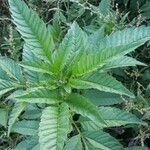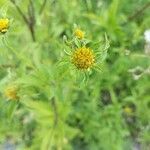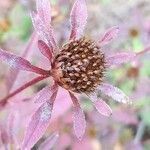Annuals, (15–)30–50(–150) cm. Leaves: petioles 10–50 mm; blades ± deltate to ovate overall, 50–100(–150+) × (15–)30–80(–120+) mm, usually laciniately 1-pinnatisect or 3–5-foliolate, primary lobes or leaflets ± lanceolate, 20–80(–120) × 10–25(–40+) mm, blades rarely 2–3-pinnatisect, bases cuneate, ultimate margins dentate to serrate, little, if at all, ciliate, apices acute to attenuate, faces glabrous or ± hispidulous. Heads borne singly or in 2s or 3s or in open, corymbiform arrays, erect. Peduncles (10–)40–150+ mm. Calyculi of 10–16(–21) ascending to spreading, spatulate to linear, seldom foliaceous bractlets or bracts 10–20(–40) mm, margins usually hispid-ciliate, abaxial faces ± hispidulous. Involucres hemispheric or broader, 5–6 × 8–10 mm. Phyllaries 10–12, ovate to lanceolate, 6–9 mm. Ray florets 0 or 3–5+; laminae pale yellow, 2.5–3.5 mm. Disc florets 40–60(–150+); corollas yellow, 2.5–3.5 mm. Cypselae purplish, brown, olive, or stramineous, ± flattened, obovate to cuneate, outer 6–10 mm, inner 8–12 mm, margins (sometime ± winged) proximally antrorsely, distally retrorsely barbed, apices ± truncate, faces obscurely 1-nerved, sometimes tuberculate, glabrous or sparsely strigillose; pappi of 2 erect to divergent, retrorsely barbed awns 3–4(–7) mm. 2n = 24, 48.
More
Much like no. 9 [Bidens frondosa L.], averaging a little more robust and larger-headed, the herbage glabrous to densely villous-puberulent; outer invol bracts in well developed heads 10–16(–21), typically 13, averaging a little more leafy; disk yellow; anthers mostly included; achenes to 12 mm, dark as in no. 9, or more commonly olivaceous or somewhat yellowish; 2n=24, 48. Wet to dryish waste places; widespread in n. U.S. and adj. Can., s. to N.C., Mo., and Calif. Aug.–Oct. (B. puberula)






